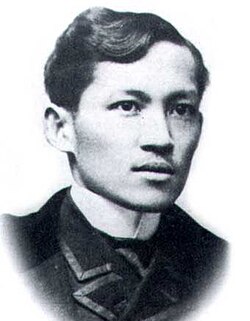Jose P. Rizal
| José Rizal | |
|---|---|
 |
|
| Born |
José Protasio Rizal Mercado (y) Alonso June 19, 1861 Calamba, Laguna, Spanish Philippines |
| Died | December 30, 1896 (aged 35) Bagumbayan, Manila, Spanish Philippines |
| Cause of death | Execution by firing squad |
| Monuments |
Luneta Park, Manila, Calamba, Laguna, Daet, Camarines Norte |
| Other names | Pepe, Jose (nicknames) |
| Alma mater | Ateneo Municipal de Manila, University of Santo Tomas, Universidad Central de Madrid |
| Organization | La Solidaridad, La Liga Filipina |
| Spouse(s) | Josephine Bracken (1896) |
| Parent(s) | Francisco Mercado Rizal (father) Teodora Alonso Realonda (mother) |
| Signature | |
|Dr. José P. Rizal (sculpture)}}
José Protasio Rizal Mercado y Alonso Realonda, widely known as José Rizal (Spanish pronunciation: [xoˈse riˈsal]; June 19, 1861 – December 30, 1896), was a Filipino nationalist and polymath during the tail end of the Spanish colonial period of the Philippines. An ophthalmologist by profession, Rizal became a writer and a key member of the Filipino Propaganda Movement which advocated political reforms for the colony under Spain.
He was executed by the Spanish colonial government for the crime of after an anti-colonial revolution, inspired in part by his writings, broke out. Though he was not actively involved in its planning or conduct, he ultimately approved of its goals which eventually led to Philippine independence.
He is widely considered one of the greatest heroes of the Philippines, and is implied but not officially by Philippine law to be one of the national heroes. He was the author of the novels Noli Me Tángere and El filibusterismo, and a number of poems and essays.
José Rizal was born in 1861 to Francisco Mercado and Teodora Alonso in the town of Calamba in Laguna province. He had nine sisters and one brother. His parents were leaseholders of a hacienda and an accompanying rice farm by the Dominicans. Both their families had adopted the additional surnames of Rizal and Realonda in 1849, after Governor General Narciso Clavería y Zaldúa decreed the adoption of Spanish surnames among the Filipinos for census purposes (though they already had Spanish names).
...
Wikipedia
